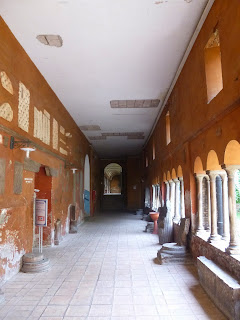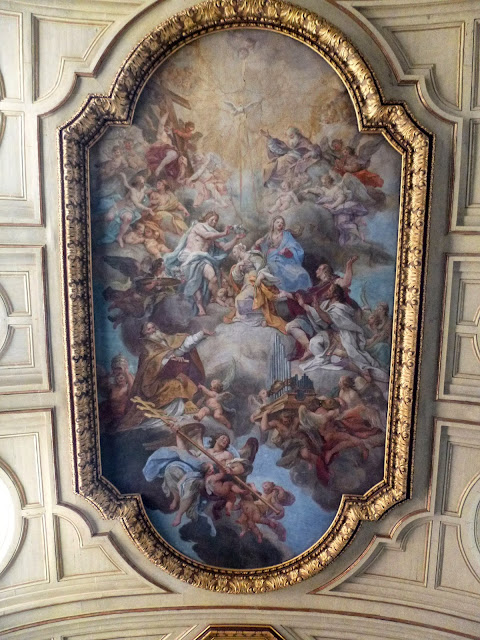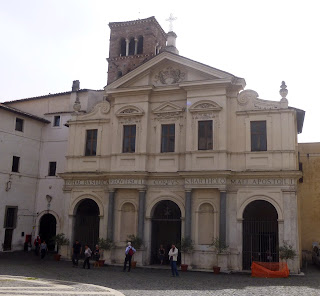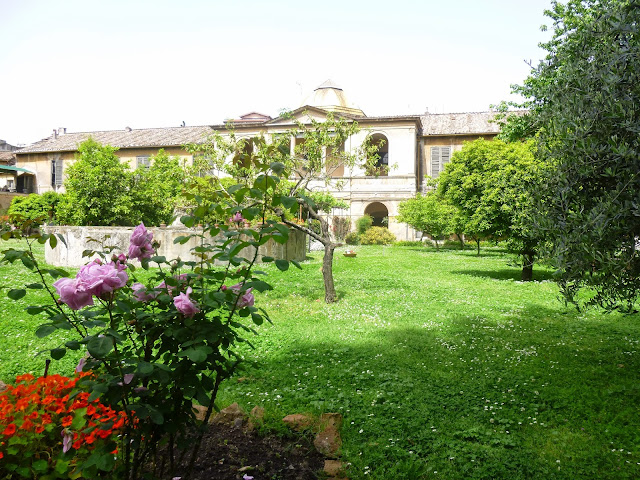


Deborah takes me first to an old convent & church, hidden in the Ospedale Nuovo Regina Margherita.
San Cosimato in Trastevere is a 15th century former convent church in the rione Trastevere.








 Fairly early on in its history, the monastic complex was nicknamed San Cosimato or "Little St Cosmas" to distinguish it from the basilica of Santi Cosma e Damiano in the Forum. Hence, there is no such saint as St Cosimatus.
Fairly early on in its history, the monastic complex was nicknamed San Cosimato or "Little St Cosmas" to distinguish it from the basilica of Santi Cosma e Damiano in the Forum. Hence, there is no such saint as St Cosimatus.
The first church certainly known to
have been here was built between 936 and 949 for a Benedictine abbey called Santi
Cosma e Damiano a Mica Aurea. This was founded by Benedict, Count of
Campagnia, and was part of a major reform of Benedictine monasticism at the
time focused on the abbey of Cluny.





Our next visit is to the
Basilica di San Crisogono.




Remains from the first church,
possible from the reign of Constantine I,
and earlier Roman houses can be seen in the lower parts, reached by a staircase
in the sacristy.
The church had an uncommon form; rather than the normal
basilical plan with a central nave and two aisles on the sides, it has a single
nave.
Several sarchofagi have been preserved here, some beautifully decorated.

The paintings are from the 8th to the 11th century, and include Pope Sylvester Capturing the Dragon, St Pantaleon Healing the Blind Man, St Benedict Healing the Leper and The Rescue of St Placid.



The only medieval church dedicated to St. Benedict to have survived to the present day, S. Benedetto in Piscinula was constructed in the early twelfth-century.
The site itself, however, has a tradition that connects it to Benedict long before the twelfth-century. It is said to be the place where St. Benedict lived when in Rome as a young man and, more importantly, where he prayed.



We now walk back towards the Tiber, admiring some more beautiful decorated facades.

 |
| View on the Ponte Garibaldi |


 We cross the Ponte Cestio to Tiber Island to visit the
We cross the Ponte Cestio to Tiber Island to visit the Basilica di San Bartolomeo.
t is not known when the Tiber Island first became part of the city, although it may have been a convenient and safe place to lodge even in Stone Age times. It is now clear that there has been an island in the river or its marshes for a very long time, since it is the remnant of a side-vent of the ancient volcano that created the adjacent Capitoline.
The first temple on the island was dedicated, appropriately, to the river-god Tiberinus. The temple and its precinct
was rebuilt in the 1st century AD.
The first documentary reference to the
dedication to St Bartholomew dates from 1088.
The church has had repeated
problems with flooding by the river. As a result, it has needed several restorations.
There was a final restoration in 2000. In the same year, the church was made into a shrine of
those suffering martyrdom for their Christian faith in the 20th century.
 We now cross the
We now cross the Ponte Fabricio, the oldest bridge in rome, built in 62 BC and still existing in its original state.
An original inscription on the travertine commemorates its builder in Latin, L . FABRICIVS . C . F . CVR . VIAR | FACIVNDVM . COERAVIT | IDEMQVE | PROBAVIT. (Lucius Fabricius, Son of Gaius, Superintendent of the roads, took care and likewise approved that it be built)
 The Pons Aemilius, today called Ponte Rotto, is the oldest stone bridge in Rome. Preceded by a wooden version, it was rebuilt in stone in the 2nd century BC. It once spanned the Tiber, connecting the Forum Boarium with Trastevere. A single arch in mid-river is all that remains today, lending the bridge its name Ponte Rotto ("Broken bridge").
The Pons Aemilius, today called Ponte Rotto, is the oldest stone bridge in Rome. Preceded by a wooden version, it was rebuilt in stone in the 2nd century BC. It once spanned the Tiber, connecting the Forum Boarium with Trastevere. A single arch in mid-river is all that remains today, lending the bridge its name Ponte Rotto ("Broken bridge").

Europe’s largest, the synagogue was built between 1901 and 1904 in Rome’s Jewish ghetto.
 The temple was constructed between the most important symbols of Rome’s rediscovered religious freedom: the Campidoglio, seat of the city government, and the Janiculum, emblem and site of the famous 1849 battle between the Garibaldi-led Republican forces of the Risorgimento and
The temple was constructed between the most important symbols of Rome’s rediscovered religious freedom: the Campidoglio, seat of the city government, and the Janiculum, emblem and site of the famous 1849 battle between the Garibaldi-led Republican forces of the Risorgimento and French troops allied to the Pope.



 |
| The Temple of Porthunus |
 |
| The temple of Vesta or Hercules Invictus ? |
 |
| Fontana dei Tritoni aka Fontana della Bocca della Verità |
The basin has the
shape of a star and the tritons support a shell with inside a mountain. it in
the image used as background for this page).
Santa Maria in Cosmedin.
Santa Maria in Cosmedin.

Records about the church say that it already existed in the VIth century when it was used by the Greek officers of the Byzantine administration of Rome; for this reason it was called in Schola Graeca.
In 782 it was enlarged and embellished by Pope Hadrian I and at this time it was called Kosmidion (embellishment in Greek) which originated the current name.
 |
The pavement of the church has a very fine XIIth century "Cosmati" decoration.
|
The interior of the church has been mostly restored to its appearance in the 8th century with some of the additions from the 12th century.

Fragment of an 8th century mosaic displayed in the sacristy of Santa Maria in Cosmedin. It was part of a huge mosaic commissioned by Pope John VII (705-07) for an oratory in St. Peter's Basilica. The full mosaic measured 9 meters long by 6 meters high and centered on a large portrait of the Virgin with the pope, surrounded by seven scenes from her life. This is part of one of the seven scenes, depicting the Adoration of the Magi. It was donated to the church in 1639.
The classical columns are topped with finely carved capitals, some reused from Roman buildings and some made in the 8th century.
 In recent years S. Maria in Cosmedin has become a "must see" in most tours of Rome. The reason for this interest lies in an ancient circular relief, called the "Boca de la verità" which was placed in the porch in 1632; most likely it was the slab of a drain of nearby Cloaca Maxima. It portrays a human face with an open mouth which is believed to close upon the hand of any perjurer.
In recent years S. Maria in Cosmedin has become a "must see" in most tours of Rome. The reason for this interest lies in an ancient circular relief, called the "Boca de la verità" which was placed in the porch in 1632; most likely it was the slab of a drain of nearby Cloaca Maxima. It portrays a human face with an open mouth which is believed to close upon the hand of any perjurer. By now we are both extremely hungry, but on our way to the restaurant we discover another secret place, the Casa di Riposa Santa Francesa Romana.
By now we are both extremely hungry, but on our way to the restaurant we discover another secret place, the Casa di Riposa Santa Francesa Romana.




Recent restorations were done in the 18th century.
 The ceiling of Cappella dei Ponziani was decorated God the Father with evangelists (1470) by Antonio del Massaro (Antonio da Viterbo or il Pastura).
The ceiling of Cappella dei Ponziani was decorated God the Father with evangelists (1470) by Antonio del Massaro (Antonio da Viterbo or il Pastura). Among the most remarkable works is the graphic altar sculpture of St. Cecilia (1600) by the late-Renaissance sculptor Stefano Maderno.
Among the most remarkable works is the graphic altar sculpture of St. Cecilia (1600) by the late-Renaissance sculptor Stefano Maderno.
The Martyrdom of St. Cecilia
After locking Cecilia in her own steam room for three days failed to do her in—indeed, Cecilia came out singing, for which she later was declared the patron saint of music—the executioners tried decapitating her. The three allowed strokes of the axe failed to finish the job however, and Cecilia held on for another three days, slowly bleeding to death and converting hundreds in the process with her show of piety (and this obvious evidence of the power of the God protecting her).
 The apse above the choir is decorated with a fine 9th-century mosaic. It depicts a standing figure of Christ, flanked by Pope Paschal I, St. Agatha, and St. Paul on the left and St. Peter, St. Valerian and St. Cecilia on the right. Below the figures are twelve sheep, the Lamb of God, and a lengthy dedicatory inscription from Paschal I.
The apse above the choir is decorated with a fine 9th-century mosaic. It depicts a standing figure of Christ, flanked by Pope Paschal I, St. Agatha, and St. Paul on the left and St. Peter, St. Valerian and St. Cecilia on the right. Below the figures are twelve sheep, the Lamb of God, and a lengthy dedicatory inscription from Paschal I.
The Cavallini frescoes hidden upstairs
The 18th-century interior redecorators slapped plaster over most of the bottom half of Cavallini's masterful Last Judgment on the entrance wall, but had to leave room for a large built-in balcony so that the cloistered nuns could attend Mass unseen.
In doing so, they unintentionally preserved the fresco’s top half, and what remains here of Christ, the angels, and apostles is stunning.
Cavallini painted this in 1293 in a magnificent break from formulaic Byzantine painting, just as his contemporary Giotto was revolutionizing art in central Italy.
For the first time, each character has a unique face and personality, and all are highly modeled with careful shading and color gradients.


We were lucky to attend the concert given by the Haarlem Choir School from the Netherlands.
You can listen to some of the music on the videos below.


 After this beautiful interlude, we go for a delightful lunch at another of Deborah's favorite Osterias " Le Mani in Pasta"
After this beautiful interlude, we go for a delightful lunch at another of Deborah's favorite Osterias " Le Mani in Pasta"
 We continue our walk
We continue our walk



Basilica di Santa Maria in Trastevere
 Santa Maria in Trastevere was probably built around 350 AD under Pope Julius I (337-52). In this early period the church was known as titulus Callisti. It was partially destroyed by fire during the sack of Rome in 410, then repaired and rededicated to the Virgin Mary by Pope Celestine (422-32). More restoration took place during the 8th and 9th century.
Santa Maria in Trastevere was probably built around 350 AD under Pope Julius I (337-52). In this early period the church was known as titulus Callisti. It was partially destroyed by fire during the sack of Rome in 410, then repaired and rededicated to the Virgin Mary by Pope Celestine (422-32). More restoration took place during the 8th and 9th century.
The church was totally rebuilt in the 12th century by Pope Innocent II (1130-43), using materials from the ancient Baths of Caracalla. Most of the present building dates from this era, with the portico and some other remodelling from the 19th century.
 The façade was restored by Carlo Fontana in the 17th century, but its faded mosaics date from the 12th or 13th centuries. The portico is a 19th-century addition; displayed inside are fragments from the earlier churches, dating from the 4th to 9th centuries. They were found during excavations beneath the 12th-century floor of the church.
The façade was restored by Carlo Fontana in the 17th century, but its faded mosaics date from the 12th or 13th centuries. The portico is a 19th-century addition; displayed inside are fragments from the earlier churches, dating from the 4th to 9th centuries. They were found during excavations beneath the 12th-century floor of the church. The restored mosaics on the apse vault and triumphal arch date from around 1140. The triumphal arch depicts the Four Evangelists, the prophets Isaiah and Jeremiah, caged birds representing sin, seven candlesticks, and a Christogram (chi-rho). The apse vault shows the Coronation of the Virgin with saints and Pope Innocent II holding a model of the church.
The restored mosaics on the apse vault and triumphal arch date from around 1140. The triumphal arch depicts the Four Evangelists, the prophets Isaiah and Jeremiah, caged birds representing sin, seven candlesticks, and a Christogram (chi-rho). The apse vault shows the Coronation of the Virgin with saints and Pope Innocent II holding a model of the church.


 On the nave walls above the columns are frescoes of saints. These sixteen paintings were ordered by Pope Pius IX and executed in the years 1865-66 by different artists. Oddly, the backgrounds of these paintings are faked to look like mosaic work. The artists are listed as: Left side- Cortes, Wedmer, Sereni, Bartolommei, Sogni, Scaccioni and Fontana; right side- Fracassini, Minocchi, Cappanari, Vincenzo Mercuri, Chiari and Marini. This list only has thirteen names, so some of them painted more than one.
On the nave walls above the columns are frescoes of saints. These sixteen paintings were ordered by Pope Pius IX and executed in the years 1865-66 by different artists. Oddly, the backgrounds of these paintings are faked to look like mosaic work. The artists are listed as: Left side- Cortes, Wedmer, Sereni, Bartolommei, Sogni, Scaccioni and Fontana; right side- Fracassini, Minocchi, Cappanari, Vincenzo Mercuri, Chiari and Marini. This list only has thirteen names, so some of them painted more than one. Domenicho designed the gilded and coffered wooden nave ceiling, and also painted the Assumption of the Blessed Virgin (1617) in the octagonal cove in the middle.
Domenicho designed the gilded and coffered wooden nave ceiling, and also painted the Assumption of the Blessed Virgin (1617) in the octagonal cove in the middle.
We now return home for a little well-deserved siesta, after which we decide to return to visit the Roseto, the Rose Garden on the Aventino, which we passed on our first evening.
 Occupying a prime spot on the Aventino (Aventine Hill), the Roseto was the site of Rome's Jewish cemetery for centuries, before being presented to the city in the twentieth century. The garden layout pays tribute to the site's history, with paths forming symbols including the Menorah.
Occupying a prime spot on the Aventino (Aventine Hill), the Roseto was the site of Rome's Jewish cemetery for centuries, before being presented to the city in the twentieth century. The garden layout pays tribute to the site's history, with paths forming symbols including the Menorah.



 After dinner, at home, we take the tram to S. Giovanni in Laterano, to buy a cappuccino machine at the Nespresso shop in Coin.
After dinner, at home, we take the tram to S. Giovanni in Laterano, to buy a cappuccino machine at the Nespresso shop in Coin.
 Dedicated to John the Baptist and John the Evangelist, the Basilica of St. John Lateran (Basilica di San Giovanni in Laterano) is the first among the four major basilicas of Rome.
Dedicated to John the Baptist and John the Evangelist, the Basilica of St. John Lateran (Basilica di San Giovanni in Laterano) is the first among the four major basilicas of Rome.
It is also the cathedral of the bishop of Rome, the Pope, and is thus known as Omnium urbis et orbis Ecclesiarum Mater et Caput: "Cathedral of Rome and of the World."
Built by Constantine the Great in the 4th century, San Giovanni in Laterano was the first church to be built in Rome. It contains several important relics, a lovely 13th-century cloister and an ancient baptistery (San Giovanni in Fonte).
At this time of the day it is closed to visitors.
At this time of the day it is closed to visitors.

 The Porta San Giovanni is a gate in the Aurelian Wall of Rome.
The Porta San Giovanni is a gate in the Aurelian Wall of Rome.













































Geen opmerkingen:
Een reactie posten